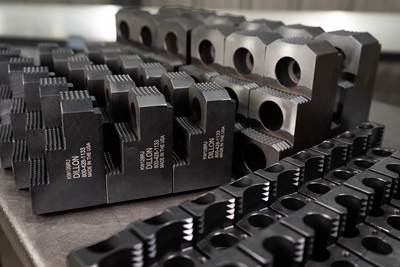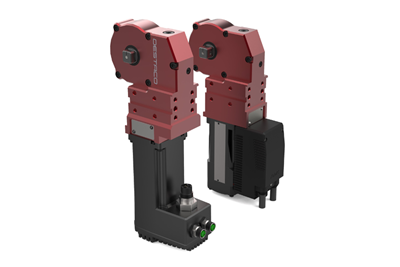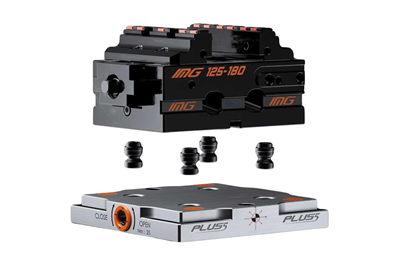Workholding
For turning centers, three-jaw chucks are the most common workholding device, gripping the outside of a bar or other type of material as the main spindle spins and turning operations are performed. For long parts, a tailstock with a dead center (doesn’t rotate) or live center (rotates with the workpiece) are used to support the opposite end of the workpiece during turning. Expanding mandrels are also available to expand inside a tube or machined bore to grip the part during turning. These provide the cutting tool full access to the entire outside diameter of a part. Quick-change collets are becoming more common to speed changeovers to new barstock sizes. A range of workholding options are available for milling machines, including vises, magnets, vacuum tables and hydraulic-actuated clamps.

ESSENTIAL READING
VIEW ALLBar Feeder Basics
Some primary factors are often overlooked when considering how to justify the implementation of a bar feeder for turning operations.
Read MoreUnderstanding CNC Collet Chucks
Workholding for turning is usually fairly basic: The selection comes down to chucks or collets. This article looks at when to consider the collet chuck and what kind might be best for a given application.
Read MoreDiscovering the Benefits of Collet Chucks
For shops making all types of parts, collet chucks can provide faster change-over, an increased gripping range, high rigidity and reduced maintenance.
Read MorePrecision Workholding Delivers Accuracy and Production Capabilities
Holding the workpiece precisely is becoming an integral aspect of the machining process. It's more than presenting the blank to the cutter; it also includes repeatability from blank to blank.
Read MoreSubspindle Workholding Options
The advent of subspindle turning operations has impacted throughput for many shops. Understanding workholding options available for backworking can help a shop make better decisions when specifying how to hold parts for op. 20.
Read MorePrecision Workholding Offers Multiple Advantages
As American manufacturing continues to transition from the mass production of conventional parts to the manufacture of complex, high-value components in relatively small lot sizes, precision workholding has assumed increased importance
Read MoreLatest Products
Speedgrip Chuck Workholding Solutions Reduce Setup Times
IMTS 2024: Speedgrip Chuck Co. showcases its QCR quick-change receiver to attach to CNC lathe spindles, as well two turning chucks designed to reduce the amount of time needed to change clamping and other workholding devices.
Read MoreDillon Reversible Hard Jaws Provide Secure Parts Gripping
The company’s reversible hard jaws are designed to decrease the time and cost of tool setups.
Read MoreSMW Mechatronic Grippers Automate Key Processes
The Motiact mechatronic gripper series is designed to perform precise, consistent, accurately monitored gripping operations in automated work cells.
Read MoreDestaco Electric Power Clamps Enable Flexible Production
The 92W series electric power clamps feature integrated intelligence to reduce the need for additional components.
Read MoreSMW Autoblok Vise System Provides Omnidirectional Clamping
The Plus5 V5 Zero Point Vise system interfaces with all industry-standard products using 52 mm or 96 mm pin spacing, enabling it to readily become part of existing workholding systems.
Read MoreFairlane Workholding Components Enable Modular Positioning
Fairlane Products Inc.’s Swivots workholding components swivel, pivot and tilt to compensate for angles and irregularities of the workpiece.
Read MoreFeatured Posts
The Workholding is the Hardest Part
Finding a way to fixture contoured marine propellors proved to be this shop’s biggest challenge in developing an effective automated machining and turning cell.
Read MoreChuck Jaws Achieve 77% Weight Reduction Through 3D Printing
Alpha Precision Group (APG) has developed an innovative workholding design for faster spindle speeds through sinter-based additive manufacturing.
Read MoreWhen to Use a Diaphragm Chuck
The accuracy and repeatability of these chucks make them well suited for a number of workholding applications, including turning and grinding.
Read MoreThe Value of Auto Adjust Magazine Bar Feeders
This bar feeder is designed to offer the flexibility to enable CNC turning centers to perform short-run work that would otherwise require frequent setups over a range of barstock diameters.
Read MoreJob Shop Discovers and Fills a Fishing Need
The promise of a product line for improved mounting of electronic fish finders led this Missouri job shop to an automated turning process.
Read MoreBar Feeder Designed with Swiss-Types in Mind
New technology enables this bar feeder to fully support the bar pusher and stock from inside the unit all the way to the spindle of a sliding headstock lathe.
WatchFAQ: Workholding
How does a three-jaw chuck work?
For turning centers, three-jaw chucks are the most common workholding device, gripping the outside of a bar or other type of material as the main spindle spins and turning operations are performed.
What is a mandrel?
Expanding mandrels are available to expand inside a tube or machined bore to grip the part during turning. These provide the cutting tool full access to the entire outside diameter of a part.
What is a collet?
Collets are generally used when the diameter of the part or bar to be gripped ranges from 1/16 inch to 2.5 inches. Compared with standard triple-jaw chucks with soft jaws, standard collets tend to be inexpensive and more accurate for gripping in the small-to-medium range.
When a collet-type workholding device is used, the part being gripped and machined will be closer to the headstock bearings on the machine tool or indexing fixture than is the case when using a power chuck.
Source: Collets Vs. Chucks
How do you use a vise?
According to Mr. Wolfe, "any vise has a bending moment associated with the clamping force applied. Take for example a 6-inch vise held down by its four corners. When the vise jaws close to clamp on a workpiece, the unsupported middle will tend to bend up from the machine table. It can move 0.002 inch or more. On precise parts that may be all the tolerance there is. My suggestion is always to secure the vise base as close as possible to the center distance between the movable and fixed jaws."
Another problem for many shops is consistency from operator to operator. "Rarely do two operators use the same clamping force on a vise," says Mr. Wolfe. "Deflections of the workpiece blank can cause inaccuracies. A more expensive but more accurate pull-type vise will help reduce some clamping variability. A simple torque handle will help achieve consistent clamping on both the pull-type and the more common push-type vises."
Make it a rule of thumb," says Mr. Wolfe, "to always try to keep the workpiece as close to the vise base as possible. Usually parallels work better on this type of setup than step jaws because the operator can check the seat of the part by trying to move the parallel. If it's snug, it's good."
Source: Flexibility Is A Vise
Workholding Supplier Categories
- Chucks, Self-Contained
- Dividing & Indexing Heads
- Actuators, Hydraulic & Pneumatic
- Chucks, Gear
- Vises & Vise Jaws
- Mandrels
- Guide Bushings (for Swiss Lathes)
- Angle & Sub Plates
- Chucks, Special
- Chucks, Collet Type (for Workholding)
- All Other Workpiece Handling, Loading & Feeding Equipment not specified
- Indexers & Rotary Tables
- Collets for Workholding
- Clamps & Fixturing Devices
- Chucks, Precision
- Steady Rests
- Centers, Live & Other
- Pedestal Type Fixtures & Tombstone Blocks
- Chucks, Magnetic
- Fixturing Systems
- Workholding, Custom
- Chuck Jaws & Collets
- Chucks, Index
- Chucks, Power
- Chucks, Diaphragm
- Arbors, Expandable Workholding
- Chucks, Vacuum
- Chucks, Jaw Type


.jpg;maxWidth=300;quality=90)































